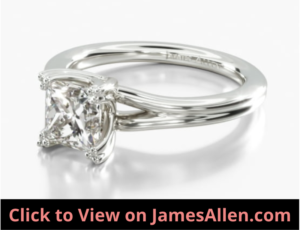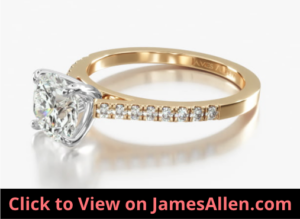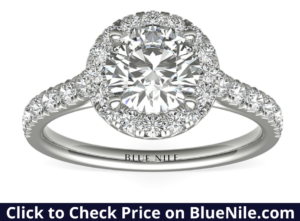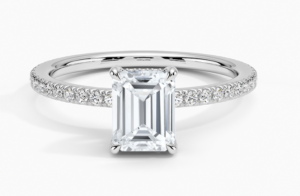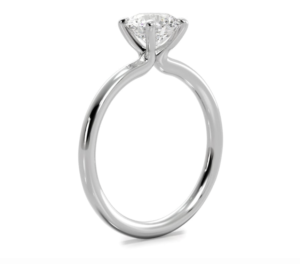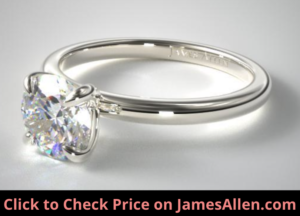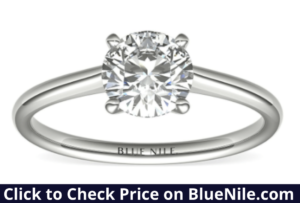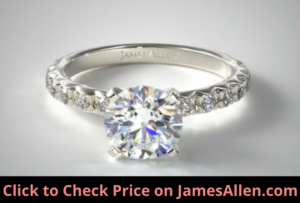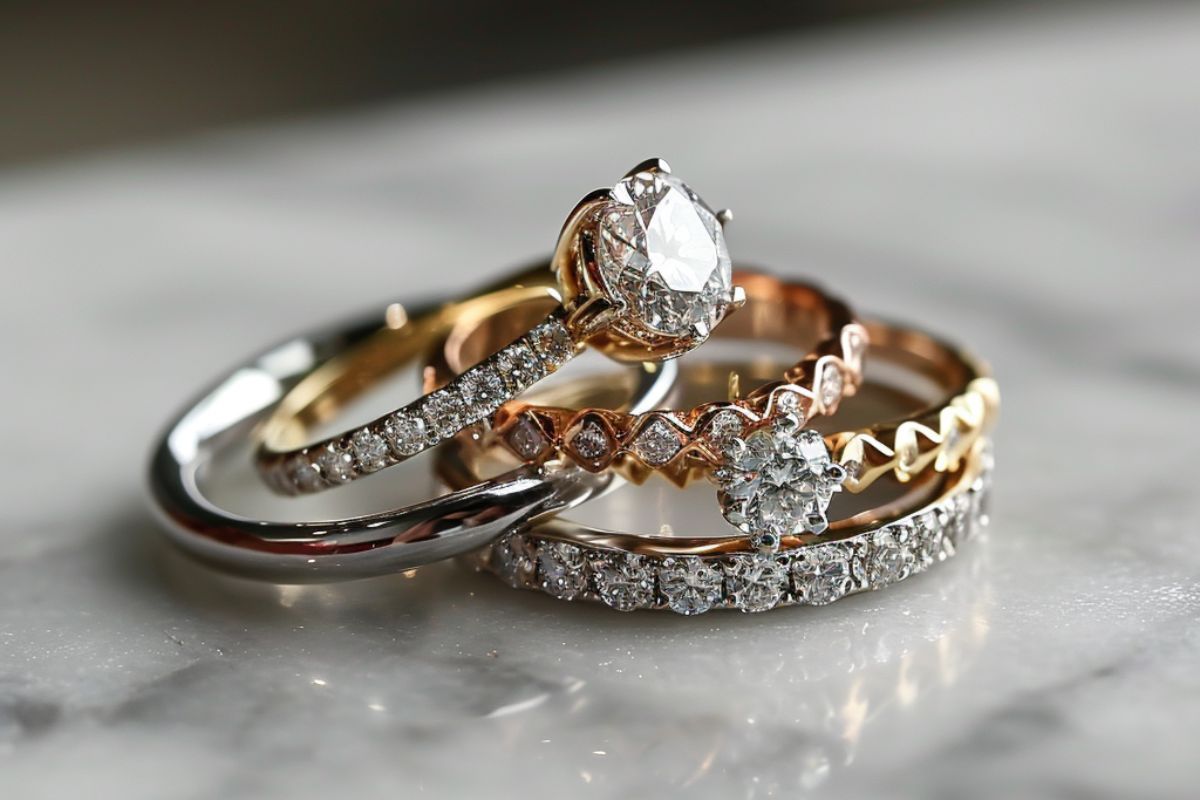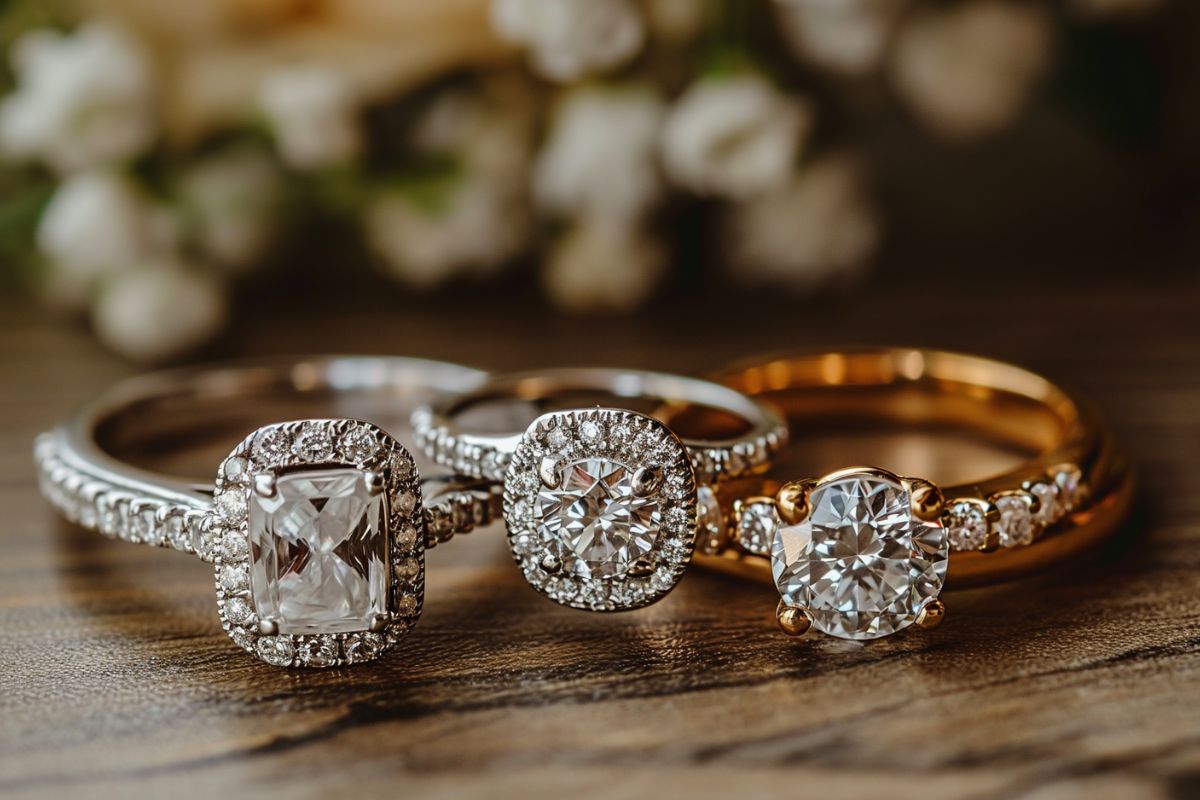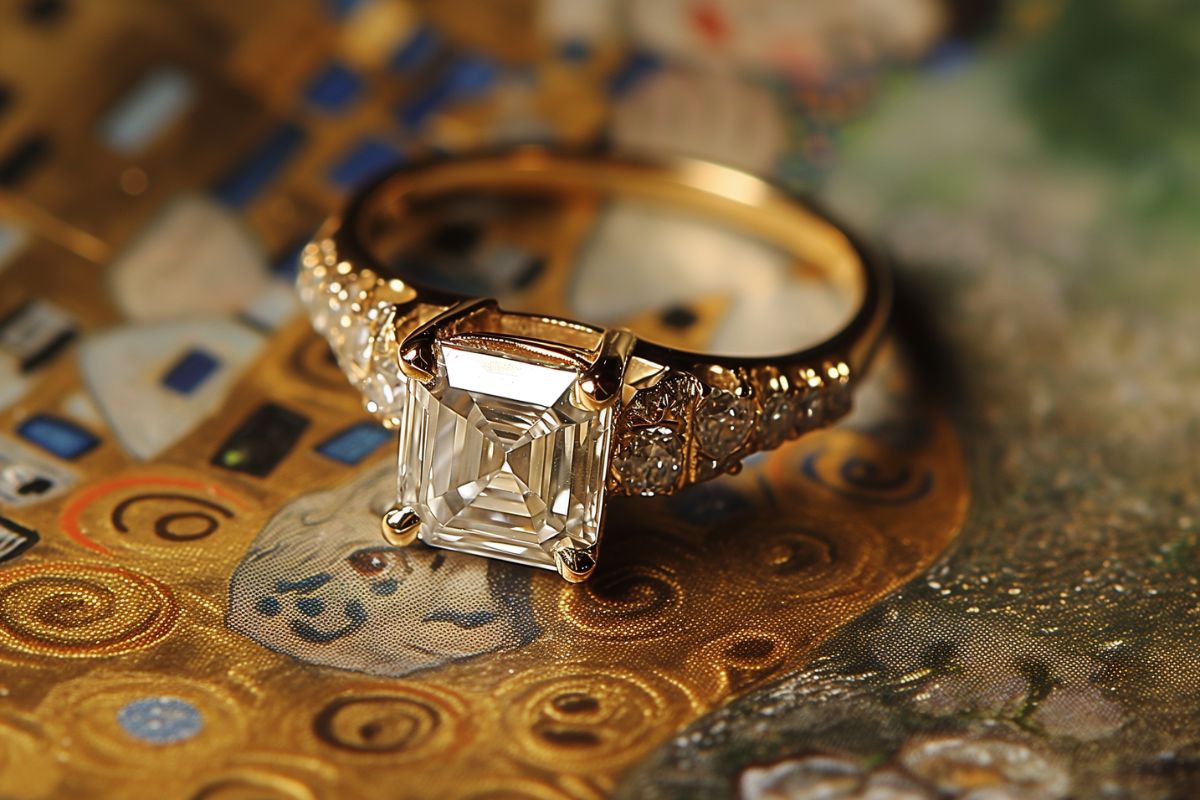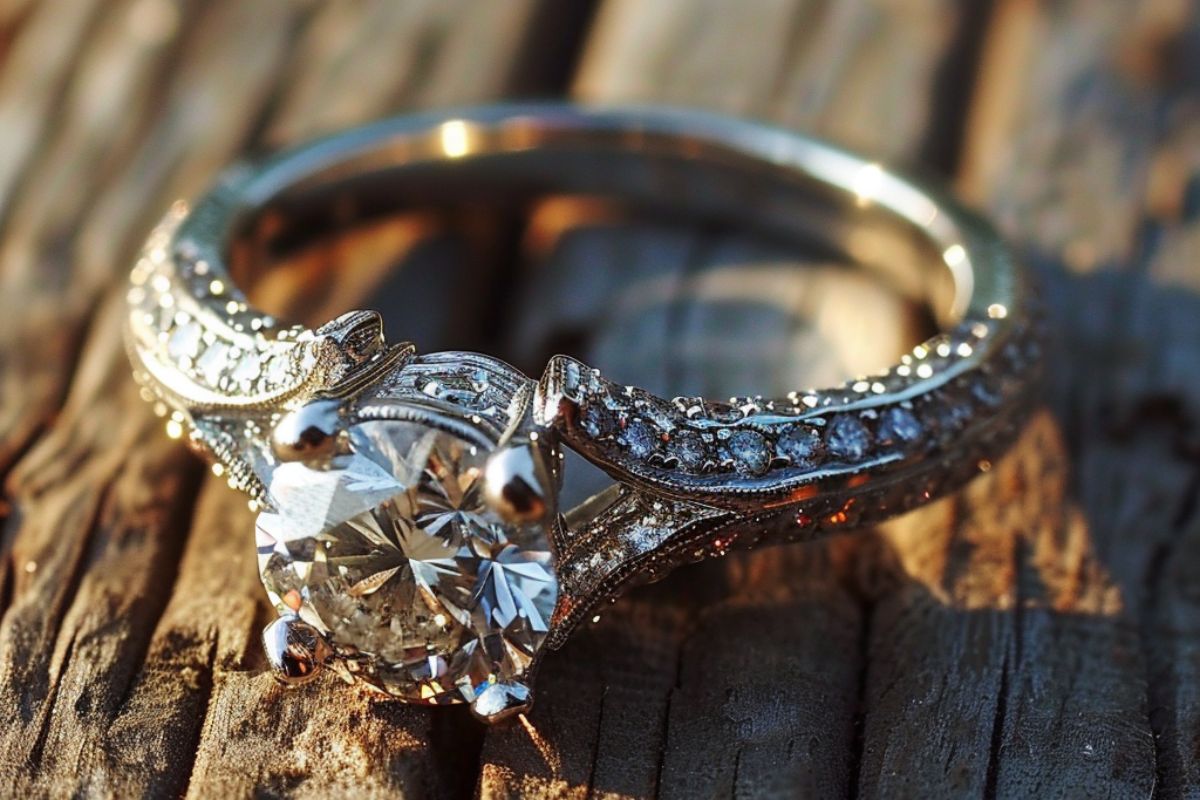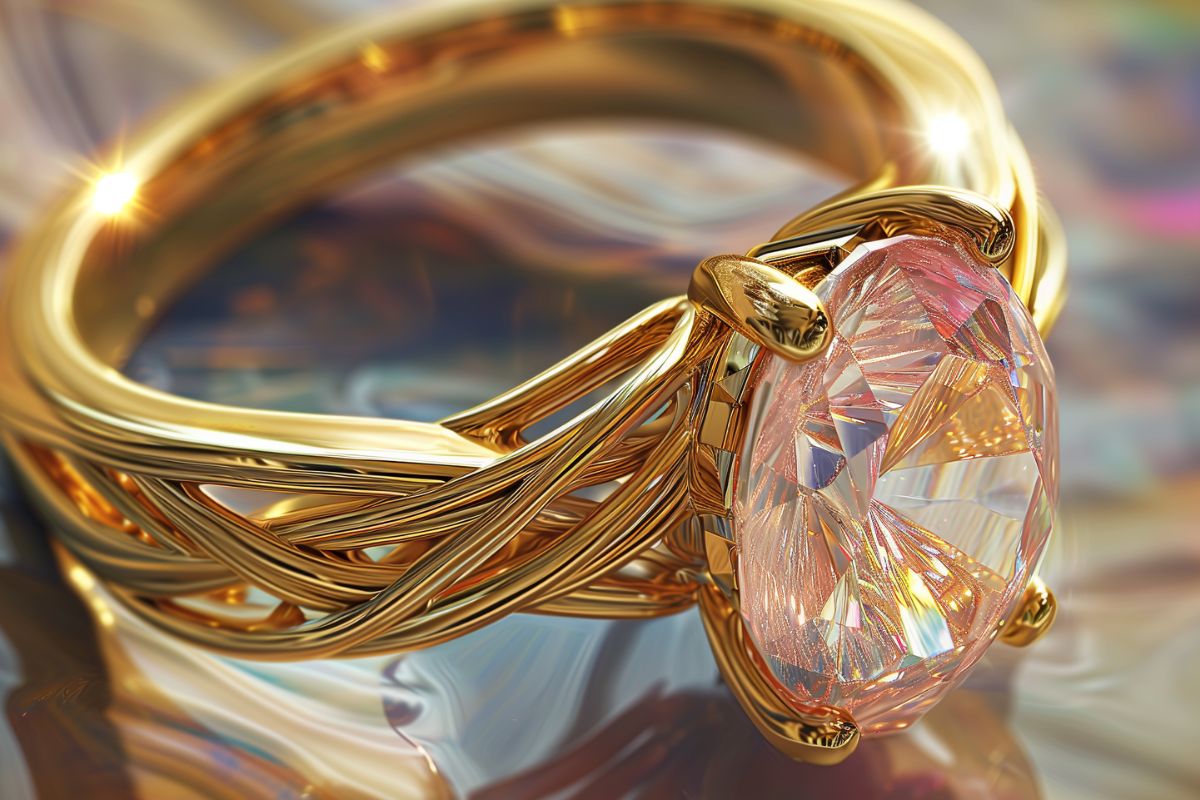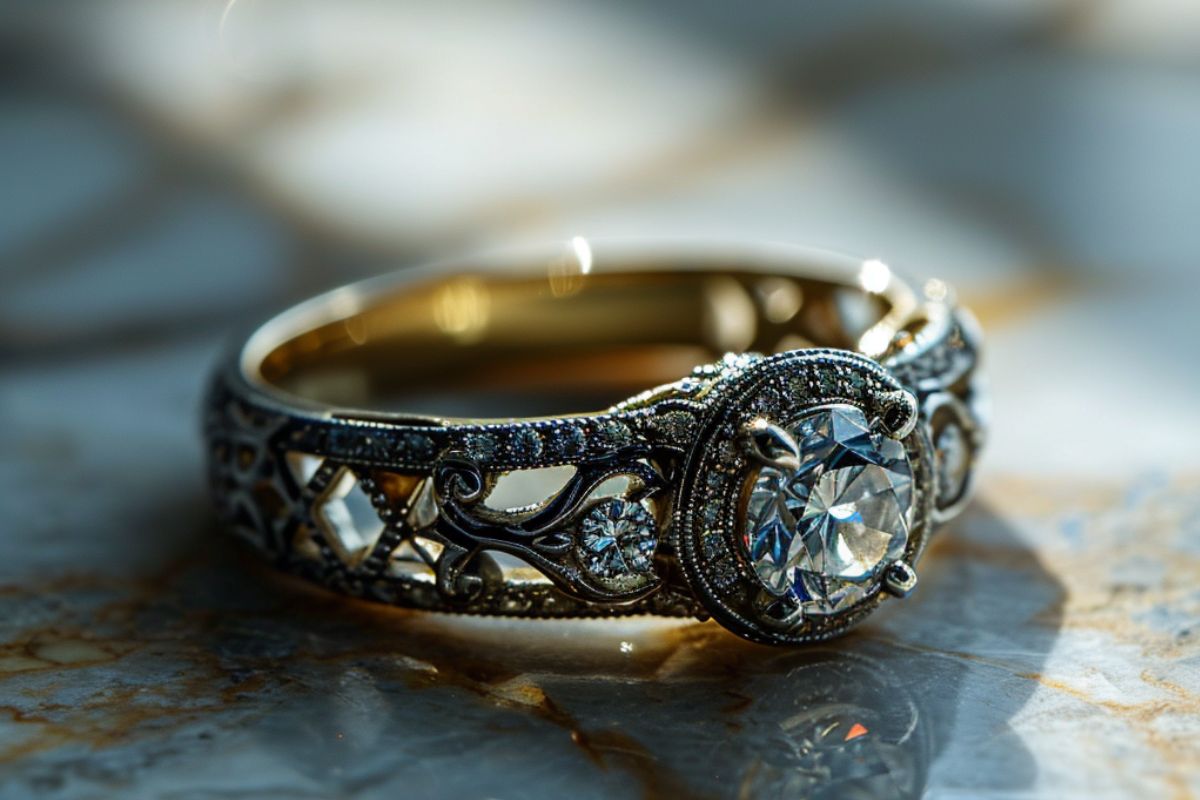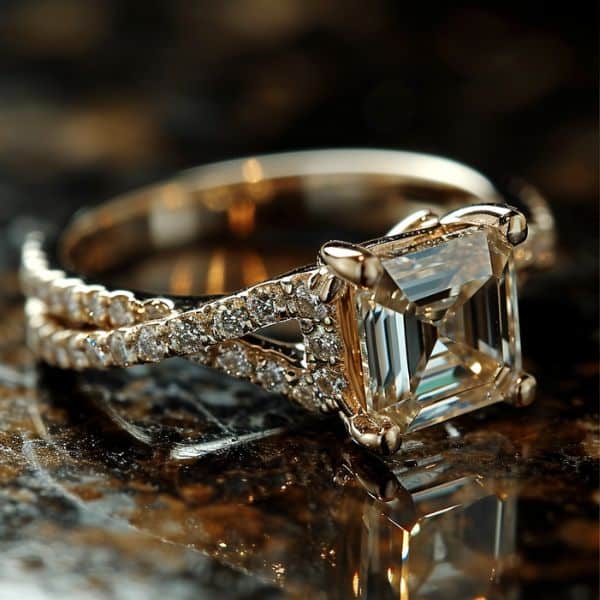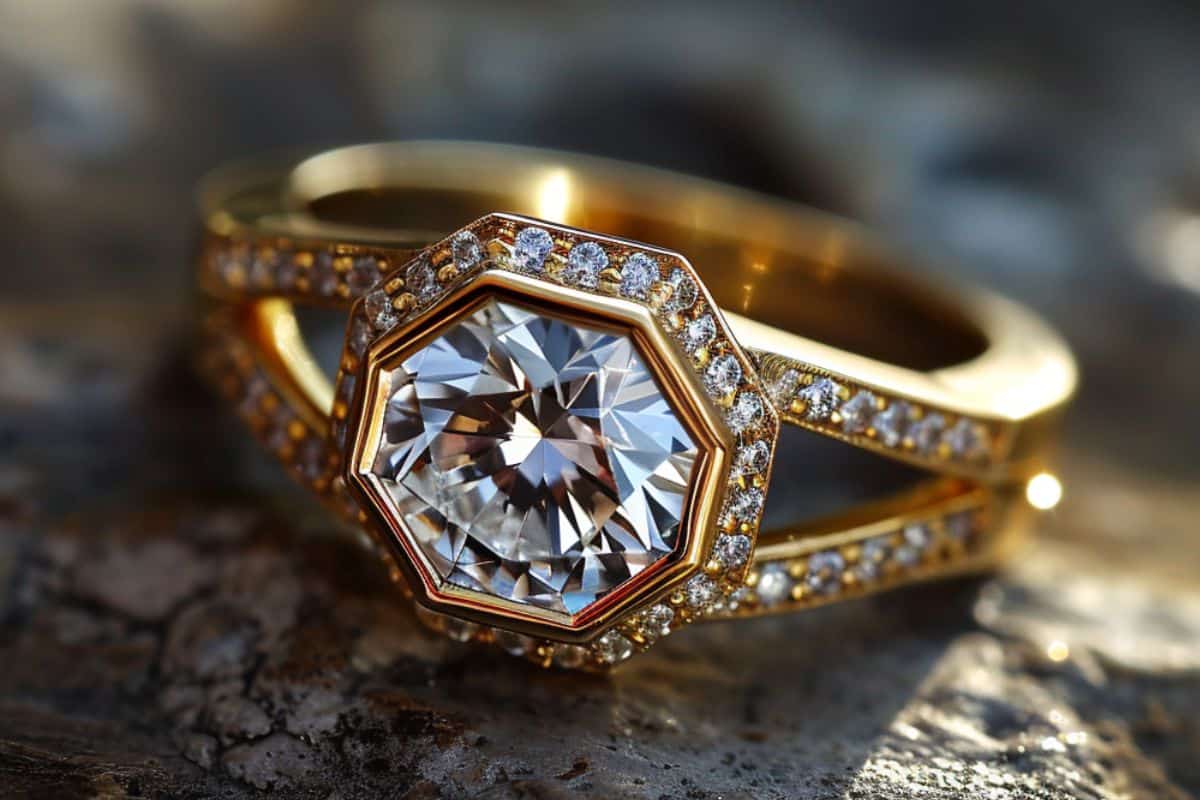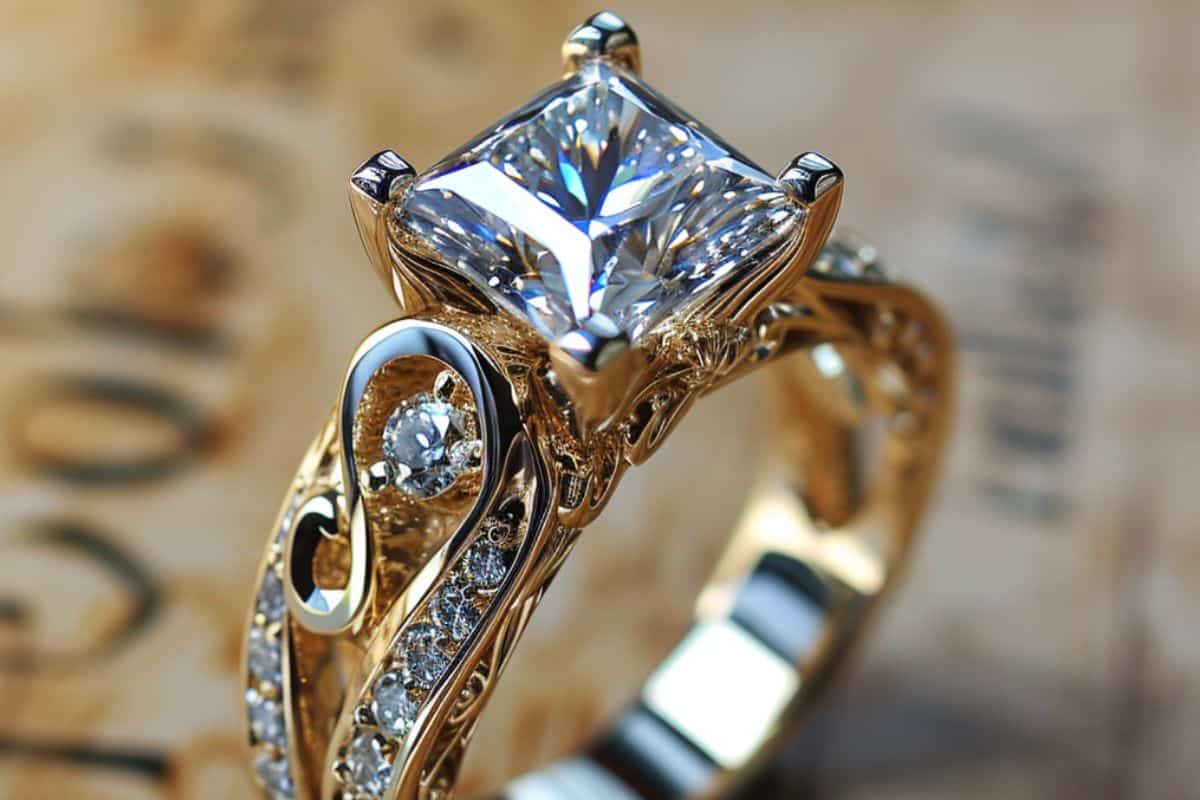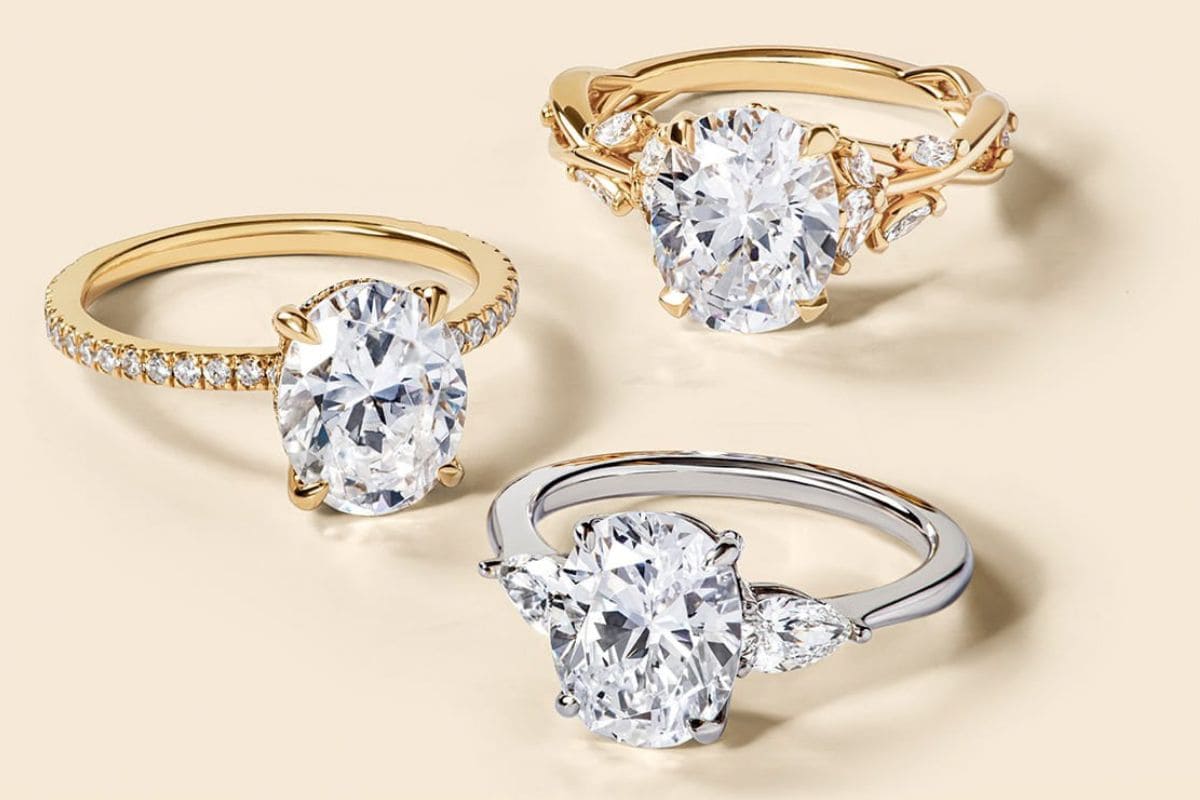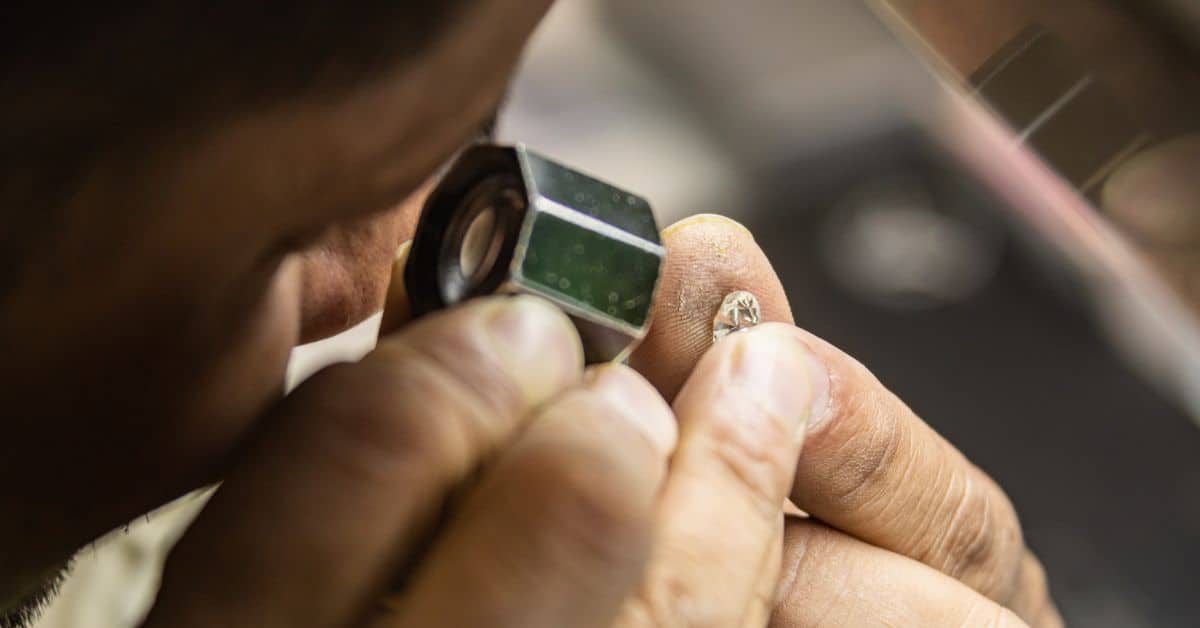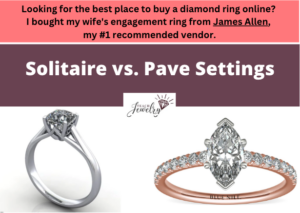
A center diamond is the focal point, but the style of ring displaying it adds overall appeal.
Solitaire and pavè (pronounced “pa-vay”) are two popular types of settings.
The main difference between solitaire and pavè settings is solitaire settings have no diamonds lining the shank, so the focus is on the center stone. Pavè settings have small diamonds placed on the band and held in place by metal beads or prongs to enhance its brilliance.
Let’s compare solitaire versus pavè settings for diamond rings, including an overview of each, six key differences, and how to decide which is right for you.
What are Solitaire Settings?
Solitaire settings only include one diamond. There aren’t additional gemstones on the band or complementing the main one, like in a halo or three-stone design.
It’s the most common choice for engagement rings because of its simplistic design and the way it doesn’t draw attention away from the main diamond.
In most cases, the diamond is held in place by three, four, or six prongs. Fewer prongs mean less security for the diamond, but it does maximize its exposure to improve light performance.
For example, this knife edge solitaire ring from James Allen, the vendor where I bought my wife’s engagement ring, holds the round-cut diamond with four prongs.
It’s a sleek, 14k white gold setting with a minimalist design.
But solitaires aren’t limited to round-cut diamonds or a thin band. They hold every diamond cut from princess and emerald to pear and marquise. Thicker bands provide support for larger diamonds.
Other designs offer an alternative from the classic style. This woven solitaire engagement ring has a split band that forms interlaced prongs.
You can view it on the vendor’s website to learn how it appears at each angle.
Its elegant profile is the ideal choice for buyers who want a clean shank but also a unique touch that differentiates it from other solitaires.
What are Pavè Settings?
Pavè settings feature small diamonds or other gemstone lining the shank.
In the example below, notice how there are eight diamonds on both sides surrounding the main one.
Those are the pavé, and they weigh a total of 0.17 carats.
The name is derived from the French word that means “pavement.”
The aesthetic gives the illusion the band is made of diamonds.
Like solitaire, pavè settings can hold any diamond cut. That’s because the pavè diamonds don’t interfere with the one on top.
They’re placed away from the center diamond, so it doesn’t matter how large or small it is, or whether there are side stones or a certain type of halo.
As an example, this engagement ring includes French pavè halfway down the shank and a halo of small diamonds encircling the main one.
The added gems aren’t competing with each other. Instead, they increase the brilliance of the piece with an extra half carat of diamonds.
Pavè settings include diamonds around the whole band or one half. If diamonds wrap the whole ring, it’s called an eternity setting. If they stop halfway, it’s called a half eternity.
Another style is a pave wrap, where they’re placed on prongs holding the diamond.
If you decide on a pavè setting, you’ll have many additional considerations, like the specific type of pavè and whether to include gems other than the ones on the band.
What are the Differences Between Them?
1. Pavè Settings Enhance Brilliance
One of the most coveted traits of a diamond ring is brilliance. It’s the white light reflecting off its facets and returning to the viewer.
Even if a ring has a large center diamond, a lack of light performance from a poor cut diminishes its appeal.
Diamond rings with pavè settings have more brilliance because there are additional facets to reflect light. Instead of only the main diamond glimmering, the entire ring sparkles.
This effect also causes the main diamond to look bigger.
If you’re on a tight budget and can’t afford a large diamond, you can compensate with a pavè setting.
This is also true if you choose a cut grade other than excellent, because a diamond’s cut is the factor that most impacts brilliance.
Pavè diamonds on the shank make up for some lack of brilliance from the center diamond and keep the piece from appearing too dull.
If you’ve chosen a step-cut like an emerald or Asscher that exhibits a soft glow instead of brilliance, consider placing pavé on the piece.
To illustrate, check out this setting.
The 60 round-cut pavé diamonds are a perfect complement for the emerald cut. There’s a clear distinction between the shape of the diamond on top and on the ring, and the small ones enhance its sparkle.
Solitaire settings don’t have this advantage. The ring’s brilliance depends on the cut, clarity, and color grade of the single diamond.
2. Center Diamond is More Prominent on Solitaire Settings
Some buyers don’t want to distract from the center diamond. In this case, I recommend a solitaire setting because it keeps attention from being drawn toward other aspects of the ring.
The center diamond is more prominent.
In addition, choose a setting where the diamond sits high above the band. It’ll capture the most amount of light.
For example, this engagement ring has a high setting.
There’s a noticeable gap between the diamond’s culet and the setting.
As a contrast, this solitaire setting is a more traditional height.
There’s a small gap between the diamond setting. It doesn’t sit too high above the band.
If you decide on a pavè setting, the main diamond is competing for attention. This is especially true if it sits low because it won’t stand out as much from all the pavè diamonds.
Take this exceptional petite pavè setting as an example.
Pavè diamonds cascade down each side, and they also form a basket that holds the diamond.
Although the piece has strong light performance apart from the center diamond, most buyers wouldn’t consider this setting with a large center gem.
3. Pavè Settings are More Expensive
Pavè settings are often more expensive than solitaires because of the additional diamonds.
All else being equal, the marginal price increase is for the small gems on the shank and the increased labor required to craft them.
In fact, solitaire settings are often the least expensive. The minimalist design is the easiest to manufacture, and there are no added costs for diamonds.
To provide a cost comparison, I found real examples of costs for pavè and solitaire settings.
This solitaire engagement ring in 14k white gold costs $780.
This setting is made from the same metal but includes French cut petite pavè diamonds on the shank. It’s priced at $1,030.
That’s a 32 percent increase in price, or $250, for a pavè setting versus solitaire.
Prices at Blue Nile are similar.
You’ll pay $890 for this petite solitaire setting in platinum.
It’s important to note pavè diamonds increase the total carat weight of your ring without the same price increase that would result from a larger center diamond.
If the pavè setting adds between 0.1-0.2 carats to the piece, you’d often pay more than $500 to add that weight to the main diamond.
That’s because the price of diamonds don’t increase linearly as they get heavier. It’s exponential. For example, four diamonds that weigh 0.25 carats generally cost less than a single diamond weighing one carat.
4. Solitaire Settings Require Less Maintenance
Solitaire settings require less maintenance because there aren’t several diamonds that can loosen, fall out, or collect debris.
If you’ve chosen a strong metal for your engagement ring and protect it with prongs or another style like bezel settings, it requires minimal upkeep and cleaning.
If it becomes dirty, place it in warm water with mild dishwashing soap. Then gently brush it and air dry it, or use a soft cloth.
Pavè settings have a higher likelihood of maintenance issues.
While I always recommend removing your ring during physical activity, this is even more important with pavè settings.
They’re also more likely to snag on clothing or furniture because spaces between the pavè diamonds are liable to catch and loosen.
Solitaire settings are also easier to resize.
Jewelers remove part of the ring and reform it to reduce its size. To make the ring larger, they can shave part of the inside.
These techniques are much more difficult if there are pavè diamonds on the shank.
I recommend having certainty on the size you’ll need if you’re searching for a pavè setting to avoid maintenance and resizing challenges.
5. Pavé Settings are Available in More Designs
You have more far choices available for pavè settings compared to solitaire.
With a solitaire setting, the main considerations are the type of metal and how the diamond is held. Most jewelry vendors offer 14K or 18K yellow, rose, or white gold.
Some include platinum in that list, which is the most expensive.
The diamond can be held by double claw prongs, V-prongs, a bezel or tension setting, and more.
Pavè settings are available in these designs as well, but you can also choose from the different types of pavè.
Two popular options are French pavè and petite pavè.
French pavè settings are also called “fishtail pavè.” Diamonds fit into V-shaped grooves that rise and fall around the shank.
When you rotate the image of this French cut pavè ring, view the eight grooves on each side of the main diamond.
Because the carat weight is so small, a higher number can fit on the ring compared to other types.
6. Solitaire is More Popular
Solitaire settings are the most popular choice for engagement rings for many of the reasons listed above.
They’re cost-effective and draw the most attention to the center diamond. It requires a diamond with a quality cut, and many buyers aim for a colorless, eye-clean aesthetic, even if its actual grades on the color and clarity scales aren’t at the top.
When I chose a solitaire setting for my wife’s ring, I made sure it met those characteristics.
But pavé is often the second most common choice. The small diamonds complement the main one and helps the piece exhibit more brilliance than you’ll find with a solitaire.
Both are worth your consideration if you’re shopping for a ring, including other popular designs like halos, three-stones, and bezels.
How to Decide Between Solitaire and Pavé Settings
Choosing between a solitaire versus pavè setting involves knowing what makes each style distinct.
Both are a common choice for engagement rings and other pieces of jewelry, so here are some tips to help you decide.
Choose a solitaire setting if:
- You have a large center diamond and want to maintain its prominence
- The cost savings allow you to choose a diamond with improved cut, clarity, carat weight, or color
- The simplistic, sleek design is appealing
Consider a pavè setting if:
- You want the entire ring to exhibit brilliance and sparkle when it’s twirled
- You’re willing to pay a higher price for extra carats on the band
- The center diamond is smaller or doesn’t have a quality cut, so you’ll enhance the ring’s overall aesthetic
By pairing diamonds with multiple pavè and solitaire settings, you’ll find the style that’s right for you.

Jacob Clarke
Jacob Clarke is the founder of TeachJewelry.com.
He earned an Applied Jewelry Professional Diploma from the Gemological Institute of America (GIA) and now brings you essential information about diamonds, settings, and more.
Jacob has consulted with leading jewelry brands, and his work has been cited in Clean Origin, Diamond Nexus and industry publications.
He's also a member of the International Gem Society.
He enjoys discussing jewelry with readers, so contact him with any questions at jacob.clarke@teachjewelry.com.

